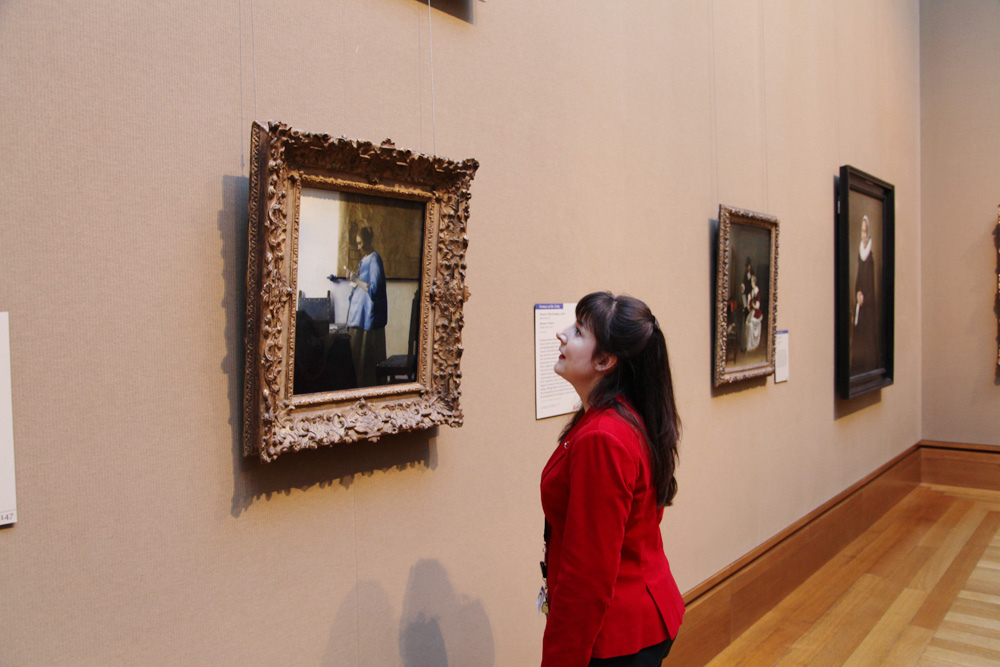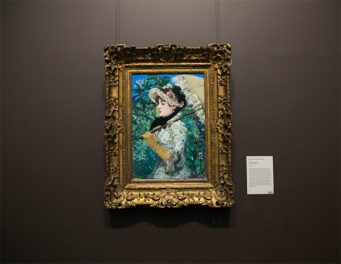
Anne Woollett, curator of Dutch paintings at the J. Paul Getty Museum
Throughout 2013, the Getty community participated in a rotation-curation experiment using the Getty Iris, Twitter, and Facebook. Each week a new staff member took the helm of our social media to chat with you directly and share a passion for a specific topic—from museum education to Renaissance art to web development. Getty Voices concluded in February 2014.
One of the most exhilarating—perhaps even the most exhilarating—experience after months of planning and envisioning a new configuration of paintings in a gallery is the instant when the long-awaited new arrival takes its place on the wall and becomes a catalyst, changing how we perceive perfectly familiar paintings. Sometimes with breathtaking immediacy, and sometimes more incrementally, the relationships between works are transformed, and individual characteristics emerge or recede in response.
On Saturday, when Vermeer’s exquisite Woman in Blue Reading a Letter took her place in the center of our large gallery of Dutch paintings, rearranged for the occasion, the impact was intriguingly complex: she seemed calmly at home, while simultaneously introducing a strong, distinctive new presence.

Woman in Blue Reading a Letter, about 1663–64, Johannes Vermeer. Oil on canvas, 18 5/16 x 15 3/8 in. (49.6 x 40.3 cm). Rijksmuseum, Amsterdam. On loan from the City of Amsterdam (A. van der Hoop Bequest)
The highly structured, almost geometric quality of Woman in Blue Reading a Letter is even more apparent here than in Amsterdam, where I last saw it in the Rijksmuseum’s conservation studio. We know that Vermeer adjusted the contours of the woman’s jacket and the left vertical edge of the map to achieve the compelling balance between fields of the white wall, strong horizontals such as the map rail, and the solid vertical of the woman in blue herself. Unlike its home environment at the Rijksmuseum, which includes three other works by Vermeer (shown below), the clarity and insistence of the composition has no parallel in the works of Vermeer’s contemporaries hanging nearby here at the Getty.

The collection of the Rijksmuseum includes four paintings by Vermeer. From left: View of Houses in Delft (“The Little Street”), 1658; The Milkmaid, 1660; The Love Letter, 1669
By comparison, Jan Steen’s The Drawing Lesson, which hangs to the left of the Woman in Blue, seems messy and far less serene than before (appropriate to the subject and the painter of brilliant wit), while the quiet interiority of the elegantly dressed young woman in Gerard Ter Borch’s The Music Lesson resonates clearly with his friend Vermeer’s sensibility.
Observing the striking monumentality of Woman in Blue, a colleague remarked, “the composition is so powerful—almost abstract, it would even look beautiful hanging upside down!”
As the painting settles in for the first week of her six-week stay with us, I’ll be examining the power of Vermeer from a variety of angles (though not upside down).
Connect with more “Power of Vermeer” content from this week’s Getty Voices:
- Wim Pijbes, director general of the Rijksmuseum in Amsterdam, and Tim Potts, director of the J. Paul Getty Museum in conversation in front of the lady herself
- The imagined text of what must have been a powerful letter, Dear “Woman in Blue,” Let Me Tell You of…
- What makes Vermeer great? Curator of Paintings, Scott Schaefer, answers with the idea of questioning.




Is this where I write the first line of the letter? I’m invited and invited to write the first line
and I’ve looked and looked as to where I should submit it—and can’t find any direction
as to how and where to submit it. So, this is the cloest I have found for “contact”—
and here is my submission:
Dear Madam:
Congratulations! You’re pregnant!
Hi Robert—We have a different post specifically for the letter, here:
Write the Opening Line to Vermeer’s Lady in Blue
However, it’s perfectly fine to share on this post as well. Thank you for contributing! —Annelisa/Iris editor
My Darling,
I hope this missive finds you well. I am doing all I can to ensure I will be at your side for the birth of our child.
My Dearest Pumpernickel,
To my frustration, the days have been interminably long and passing with such utter stagnation, but I am replete with excitement to impart to you, my dove, that our time apart is finally and joyfully drawing to an end.
My dearest darling: God forbid that I should counsel you on fashion, but do you think our gossipy neighbours understand the new fashion for wearing high-waisted full skirts under loose jackets, or will they attribute the ‘new shape’ you acquired during my absence to a usurper?